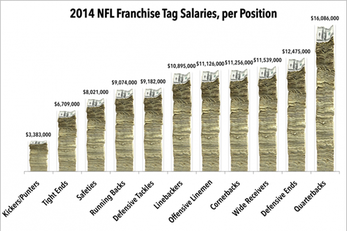
A‘Franchise Tag’ is a concept that exists in the NFL that allows each team (franchise) a once off mechanism to restrict the movement of a player that is (generally) due to become a free agent. This restricts from a player in that year from moving to another team. The window to apply the tag opened on Monday 17th February and will close on the 3rd of March.
Due to the differences in wage caps and not having transfer fees, it is almost impossible to apply to concept to association football but is a novel idea to think about all the same.
There are two types franchise tags, exclusive and non-exclusive and can get quite complex as there is also a transition tag. I’ll focus on explain the exclusive and non-exclusive tags here. Contracts in the NFL work as per association football but transfer fees are not offered to contracted players to move to other teams and once a contract ends a player becomes a free agent and thus is free to discuss, with other teams, terms and conditions. The equivalent of a footballer who is out of contract. There is also restricted free agency where the NFL team in which the player is currently playing for has the option to match other offers made to that player. Finally an NFL franchise can apply one ‘Franchise Tag’ per annum to one player to keep them at the team for at least one more year. There is set ‘Franchise Tag’ wages for the player depending on their position. For it to be an Exclusive Tag According to the NFL's collective bargaining agreement, the player must be paid the average salary of the top five players at his position or 120 percent of the player's previous year's salary, whichever is greater. The player is guaranteed his salary for the next season and the club is guaranteed his services.
A non-exclusive Franchise Tag, allows the player to negotiate contracts with other teams with their current team is given the right to match whatever contract they sign, if the team decides not to match the contract they are given two first-round picks as compensation for the loss of the franchise tag that year. The contract salary formula for a non-exclusive Franchise Tag is based off the average of the last five years of salaries for the top 5 players at that position.
Teams can keep prized assets for another year so new longer term contracts can be negotiated or they can position themselves for when the player eventually leaves.
The economics behind the concept is important as the mechanism is designed to reduce player movement. As with the Draft system in the NFL, it does not allow dominant markets (teams) to emerge as have happened in football. Coupled with salary caps, it promotes competitive balance.
A team can tag the same player for consecutive years but will have to pay 120% in the second year of the salary and 144% of the second tag salary if the wish to pursue a third year which is highly unlikely.
Problems do occur of course. At the moment the biggest story stateside is that of New Orleans Jimmy Graham. The New Orleans Saints wish to apply the tag to Graham but as a Tight End. Graham believes he is a Wide Receiver. The salary disparity is nearly $5m depending on whether he is designated as a tight end or wide receiver.
So applied to Association Football, what franchise tag would you apply to your team to restrict a player leaving in another year? With Wayne Rooney’s reported£300,000 per week contract almost agreed, assuming an opportunity cost of a large transfer fee for Rooney maybe Manchester United would have been better served allowing him to become a free agent in 2015(when current contract is up), apply the franchise tag and keep his services until 2016 when he would be 31 that October? Instead they will probably contract Rooney until 2019 when Rooney will be in his 34th year.
 RSS Feed
RSS Feed